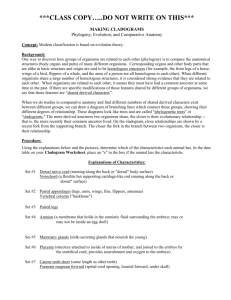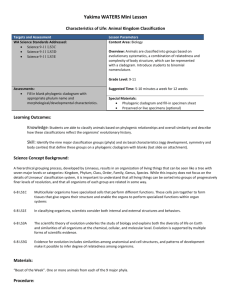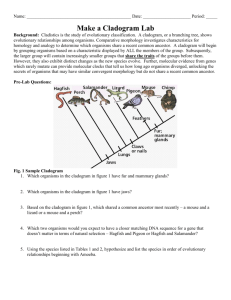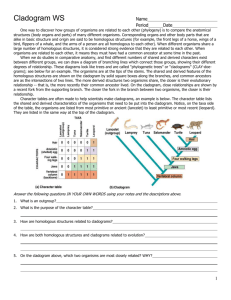Making Cladograms Lab
advertisement
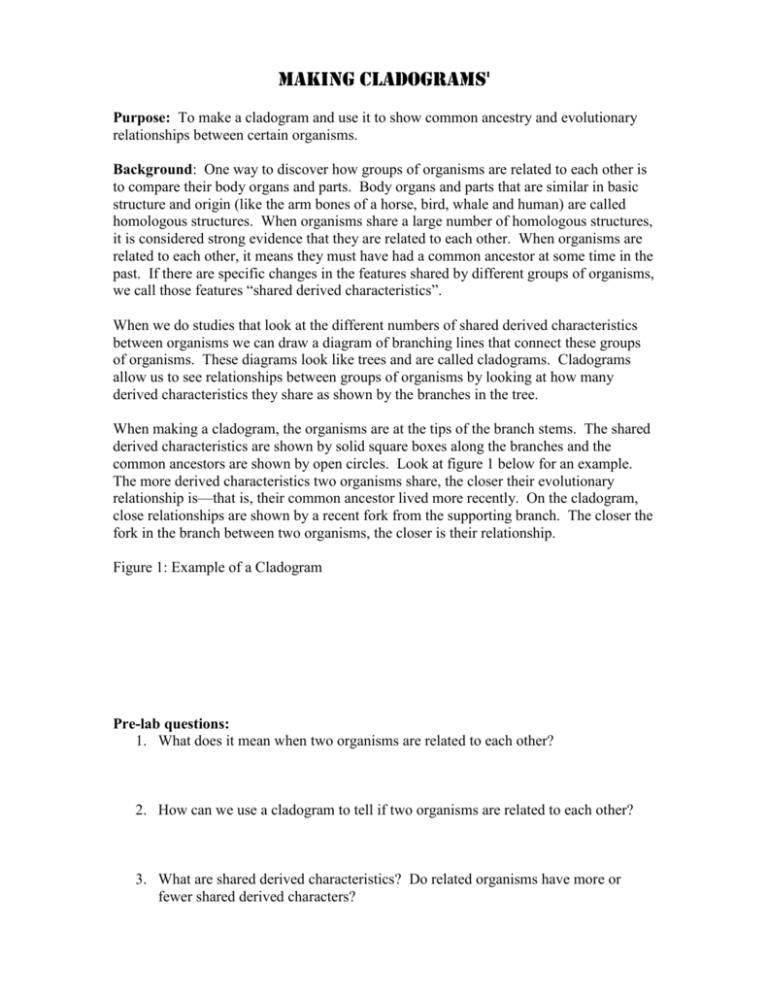
Making Cladogramsi Purpose: To make a cladogram and use it to show common ancestry and evolutionary relationships between certain organisms. Background: One way to discover how groups of organisms are related to each other is to compare their body organs and parts. Body organs and parts that are similar in basic structure and origin (like the arm bones of a horse, bird, whale and human) are called homologous structures. When organisms share a large number of homologous structures, it is considered strong evidence that they are related to each other. When organisms are related to each other, it means they must have had a common ancestor at some time in the past. If there are specific changes in the features shared by different groups of organisms, we call those features “shared derived characteristics”. When we do studies that look at the different numbers of shared derived characteristics between organisms we can draw a diagram of branching lines that connect these groups of organisms. These diagrams look like trees and are called cladograms. Cladograms allow us to see relationships between groups of organisms by looking at how many derived characteristics they share as shown by the branches in the tree. When making a cladogram, the organisms are at the tips of the branch stems. The shared derived characteristics are shown by solid square boxes along the branches and the common ancestors are shown by open circles. Look at figure 1 below for an example. The more derived characteristics two organisms share, the closer their evolutionary relationship is—that is, their common ancestor lived more recently. On the cladogram, close relationships are shown by a recent fork from the supporting branch. The closer the fork in the branch between two organisms, the closer is their relationship. Figure 1: Example of a Cladogram Pre-lab questions: 1. What does it mean when two organisms are related to each other? 2. How can we use a cladogram to tell if two organisms are related to each other? 3. What are shared derived characteristics? Do related organisms have more or fewer shared derived characters? Procedure: 1. Review data table 1 to see which characteristics each organism has. An “X” has been placed in the box if the organism has the characteristic . The characteristics are explained in appendix A at the end of the lab. 2. Use the data table to make a Venn diagram, placing the animals in groups to illustrate the characteristics that the different organisms have in common. See the figure 2 below for an example. Figure 2: Example of Venn diagram 3. Using the Venn diagrams of the groupings just completed, draw a cladogram on the larger sheet of paper to illustrate the ancestry and relationships of these animals. The diagram should reflect shared derived characteristics as time continues. Look back at figure 1 for an example. Notice how the different animals are all at the same time level (across the top) since they all live today. Analysis questions 1. What are at least two types of information that a scientist can get by using a cladogram? a. b. 2. A scientist wants to add three more organisms to this cladogram. Between which other organisms would she put them and why? a. “Iguana-like” animal: b. “Rat-like” animal: c. “Goldfish- like” animal: Data Table 1: Various Animals and the Characteristics They Have Traits Animals Kangaroo Lamprey Rhesus Monkey Bullfrog Human Snapping Turtle Dorsal Nerve Cord Notochord X X X X X X X Paired Appendages Vertebral column X X X X X X X X X X X X X X X X X X X X Paired Legs Amnion Mammary Glands Placenta Canine teeth short Foramen magnum fwd Total # of X's Venn Diagram: X Tuna Appendix A: Explanation of Characteristics Characteristic Explanation Dorsal Nerve Cord nerve cord running along the back of the body surface Notochord a flexible but supporting rod running along the back of the body surface Paired Appendages legs, arms, wings, fins, flippers, antennae Vertebral Column “backbone” Paired Legs legs in pairs Amnion membrane that holds the amniotic fluid surrounding the embryo; may or may not be inside an egg shell Mammary Glands milk-secreting glands that nourish the young Placenta structure attached to inside of uterus of mother, and joined to the embryo by the umbilical cord; provides nourishment and oxygen to the embryo Canine Teeth Short same length as other teeth Foramen Magnum Forward spinal cord opening, located forward, under skull Extension Assignment Each of the organisms in data table 1 belong to the kingdom Animalia and the phylum Chordata, however they are a part of different classes. The class they belong to is based on the specific characteristics that they have. Using your cladogram and Appendix A, can you determine which characteristics go with which class? Make a T-chart with the class on one side and the characteristic on the other. Adapted from “Evolution & Nature of Science Institutes (ENSI/SENSI) Lesson Plan: Making Cladograms” i

